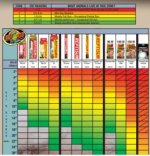DrGreatScott
New member
Temp Regulator
So for Starters, I'd like to introduce myself.
I'm currently a Biology major with a background in Herp care (having both interned at a Zoo, as well as personal pets)
I've used UTHs rather successfully in the past, but I'm re-rigging my Large Wide exo-terra by adding a divider in the middle. I'll be using an acrylic plastic that will be wedged down the middle, just left of the width cross-section.
This will allow me to house my two Geckos of similar size (one is presumably male) without harming the other or over-breeding during the mating season.
Now the issue I usually have with UTHs is where to properly place it. both sides of the tank will contain a minimum of 3 hides, where I will have 2 moist hides (one hot/one cool) and a regular hide.
My current plan involves placing the UTHs (2 total on opposite sides on the enclosure, medium sized for 10-20 gal). As such, I'd like to ensure half of each is covered by their warm moist hides while the remainder portion provides necessary ambient heat.
Now this leaves the the cool hides on the opposite sides of the tank, but I'm still debating how close to move the regular hide to the UTH.
I also have a temp regulator for the pads so they do not overheat. I have sheets of plastic to cover the top if need be for heat loss, but only if it doesn't increase humidity in the process. Usually misting the interior of the hides doesn't change it drastically, but I'm going to keep tabs regardless.
I hope I gave enough info for you to chew on. Have a good one!
***UPDATE***
I have place the UTHs in at opposite ends of the tank, with their length stretching 2-3's of the tank's width, starting at the middle.
Now my only question is where to place the sensor.
Currently, I have it underneath my reptile carpet on top of one of the UTHs. I'm using a temp gun to measure the temps and they look good so far. If I need to move it or shift it slightly, I'm all ears.
I also have the regulator set to fluctuate by 3 degrees on either side of the scale for variation (Central temp set to 87, so it can range from 84-90 at min-max). On that note, I also have a "nighttime mode" so the temp will set itself to 77 with a 3 degree range (74-80 around the hotspots)
So for Starters, I'd like to introduce myself.
I'm currently a Biology major with a background in Herp care (having both interned at a Zoo, as well as personal pets)
I've used UTHs rather successfully in the past, but I'm re-rigging my Large Wide exo-terra by adding a divider in the middle. I'll be using an acrylic plastic that will be wedged down the middle, just left of the width cross-section.
This will allow me to house my two Geckos of similar size (one is presumably male) without harming the other or over-breeding during the mating season.
Now the issue I usually have with UTHs is where to properly place it. both sides of the tank will contain a minimum of 3 hides, where I will have 2 moist hides (one hot/one cool) and a regular hide.
My current plan involves placing the UTHs (2 total on opposite sides on the enclosure, medium sized for 10-20 gal). As such, I'd like to ensure half of each is covered by their warm moist hides while the remainder portion provides necessary ambient heat.
Now this leaves the the cool hides on the opposite sides of the tank, but I'm still debating how close to move the regular hide to the UTH.
I also have a temp regulator for the pads so they do not overheat. I have sheets of plastic to cover the top if need be for heat loss, but only if it doesn't increase humidity in the process. Usually misting the interior of the hides doesn't change it drastically, but I'm going to keep tabs regardless.
I hope I gave enough info for you to chew on. Have a good one!
***UPDATE***
I have place the UTHs in at opposite ends of the tank, with their length stretching 2-3's of the tank's width, starting at the middle.
Now my only question is where to place the sensor.
Currently, I have it underneath my reptile carpet on top of one of the UTHs. I'm using a temp gun to measure the temps and they look good so far. If I need to move it or shift it slightly, I'm all ears.
I also have the regulator set to fluctuate by 3 degrees on either side of the scale for variation (Central temp set to 87, so it can range from 84-90 at min-max). On that note, I also have a "nighttime mode" so the temp will set itself to 77 with a 3 degree range (74-80 around the hotspots)
Last edited:


